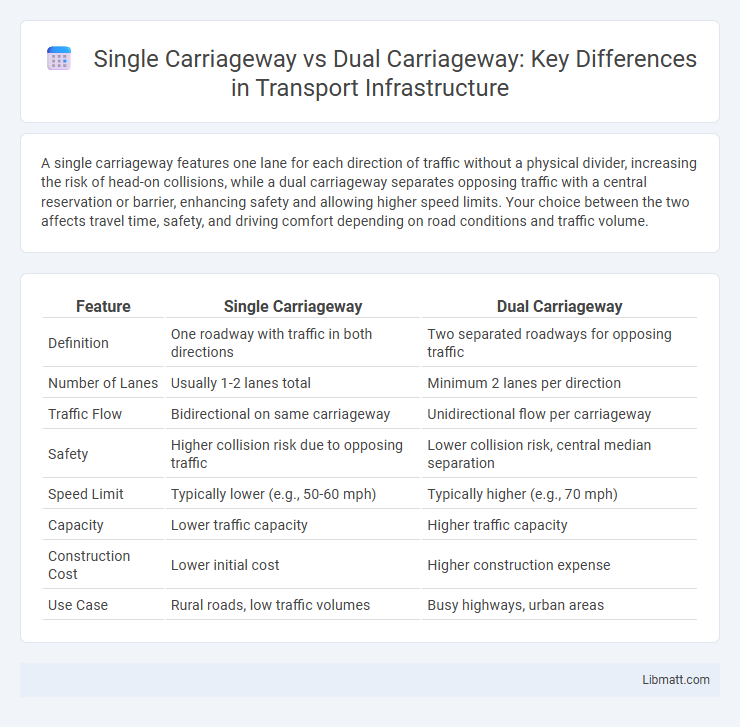A single carriageway features one lane for each direction of traffic without a physical divider, increasing the risk of head-on collisions, while a dual carriageway separates opposing traffic with a central reservation or barrier, enhancing safety and allowing higher speed limits. Your choice between the two affects travel time, safety, and driving comfort depending on road conditions and traffic volume.
Table of Comparison
| Feature | Single Carriageway | Dual Carriageway |
|---|---|---|
| Definition | One roadway with traffic in both directions | Two separated roadways for opposing traffic |
| Number of Lanes | Usually 1-2 lanes total | Minimum 2 lanes per direction |
| Traffic Flow | Bidirectional on same carriageway | Unidirectional flow per carriageway |
| Safety | Higher collision risk due to opposing traffic | Lower collision risk, central median separation |
| Speed Limit | Typically lower (e.g., 50-60 mph) | Typically higher (e.g., 70 mph) |
| Capacity | Lower traffic capacity | Higher traffic capacity |
| Construction Cost | Lower initial cost | Higher construction expense |
| Use Case | Rural roads, low traffic volumes | Busy highways, urban areas |
Introduction to Carriageways
Single carriageways consist of one lane in each direction without a physical divider, often leading to slower traffic flow and increased risk of head-on collisions. Dual carriageways feature two or more lanes separated by a central reservation or barrier, improving safety and allowing higher speed limits. These road types significantly impact traffic capacity, accident rates, and travel efficiency on highways and arterial roads.
Defining Single Carriageway
A single carriageway is a type of road with one lane for each direction of traffic, separated only by road markings rather than a physical barrier. This design typically allows vehicles to travel in opposite directions on closely adjacent lanes, often leading to slower speeds and increased risk of collisions compared to a dual carriageway. Understanding the characteristics of a single carriageway is essential for your safety and efficient route planning.
Defining Dual Carriageway
A dual carriageway is a road divided by a central reservation or barrier, separating traffic moving in opposite directions to enhance safety and traffic flow. Unlike single carriageways, which have one lane in each direction without a physical divider, dual carriageways typically feature multiple lanes per direction, reducing congestion and allowing higher speed limits. Your travel experience on dual carriageways is generally smoother and safer due to reduced collision risks and improved traffic management.
Key Structural Differences
Single carriageways feature one lane of traffic in each direction without physical separation, increasing the risk of head-on collisions. Dual carriageways consist of two or more lanes separated by a central reservation or barrier, enhancing safety by physically dividing opposing traffic flows. Understanding these key structural differences can help you anticipate traffic conditions and plan safer driving strategies.
Safety Considerations
Single carriageways typically present higher safety risks due to limited separation between opposing traffic flows, increasing the likelihood of head-on collisions. Dual carriageways enhance safety by incorporating a central reservation that reduces vehicle crossover accidents and allows safer overtaking opportunities. Road design factors such as lane width, visibility, and traffic volume significantly influence the comparative safety outcomes between single and dual carriageways.
Traffic Flow and Capacity
Single carriageways typically feature one lane per direction, limiting traffic flow and reducing capacity, especially during peak hours or in high-density areas. Dual carriageways separate traffic with a central reservation, allowing multiple lanes per direction, which significantly increases traffic flow efficiency and overall road capacity. This separation reduces congestion risks and enhances safety by minimizing head-on collision potential.
Typical Use Cases
Single carriageways are commonly used for rural and less trafficked roads, providing a cost-effective solution for connecting smaller towns and suburban areas. Dual carriageways typically serve high-traffic routes such as major intercity roads and urban bypasses, facilitating higher speeds and improved safety by separating opposing directions of traffic. Dual carriageways are preferred in regions experiencing heavy commuter flow or frequent congestion to enhance traffic capacity and reduce accident rates.
Construction and Maintenance Costs
Single carriageways typically involve lower initial construction costs due to their narrower width and simpler design, requiring less land acquisition and fewer materials. Maintenance expenses also tend to be reduced compared to dual carriageways, as there is less pavement surface to repair and fewer safety features such as central reservations or multiple lanes. However, dual carriageways, while costlier to build and maintain, offer improved traffic flow and safety, which can reduce long-term economic costs related to congestion and accidents.
Environmental Impact
Single carriageways typically have a smaller environmental footprint due to narrower roadways and less land use, resulting in reduced habitat disruption and fewer emissions from construction activities. Dual carriageways, while offering improved traffic flow and reduced congestion, often require more extensive land clearing and generate higher levels of noise and air pollution throughout their larger footprints. Assessing Your travel routes on single versus dual carriageways can influence your carbon footprint, with single carriageways generally promoting lower environmental impact.
Choosing the Right Carriageway
Selecting the appropriate carriageway depends on traffic volume, safety requirements, and road usage patterns. Dual carriageways, featuring separated lanes for opposing traffic, reduce collision risks and improve traffic flow, making them ideal for high-speed or high-traffic areas. Single carriageways suit rural or low-traffic zones where space and cost constraints prioritize simpler road designs without compromising essential connectivity.
single carriageway vs dual carriageway Infographic

 libmatt.com
libmatt.com